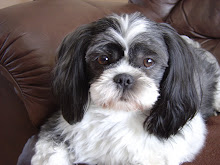
It has been said that a dog is “man's best friend” and that a well trained dog can provide much love, fun and security. However, you must remember that a dog is an animal, one that can be dangerous and inflict serious injuries and even cause death. It is, therefore, vital that just as you would train a puppy at an early age, you must educate your children in the correct ways to deal with a canine. ALWAYS remember that when a child and dog are 'loose' together that they MUST BE under adult supervision.
Children must always understand that a dog, especially a puppy, is not a toy, a doll or teddy bear. Children love being cuddled and hugged, kissed and carried around, but they also know that at times they become grumpy and irritable when adults fuss over them too much. Well, a dog is exactly the same. They do not want to be disturbed when eating or resting or sleeping but they cannot say “go away' or cry. When they get grumpy, they may snap at the offender.
Adults must be aware that young children may unwittingly encourage puppies to chase them, often leading to play biting. The puppy sees the child as one of its own and in the excitement of play an injury can occur. So this is another reason why there should always be adult supervision. Older children and even adults can be guilty of over-stimulating an excitable puppy one minute and then telling it off for the same thing a minute later and even worse hitting it the next! Adults should avoid and definitely should not let children play aggressive rough games with any puppy. This may result in an aggressive dog or a dog with behavior problems later on. Likewise, taunting or making a puppy jealous can have serious implications in an adult dog. Remembering its puppy days, an adult dog can misjudge a situation and react in the wrong way.
Children should be encouraged to leave the puppy alone unless it comes to them for attention. If they want to play with the dog, they should call it by name and get it to come to them. Just as humans dislike close face-to-face interaction so do puppies. So, children must learn not to push their faces into the dog’s, because they could risk a painful nip. Children should also be encouraged to put their toys, clothes, shoes etc. out of the reach of a puppy. This prevents the puppy from claiming these items as its own. This solves two possible problems. One, a child trying to pull items away from a dog could get bitten and two, the possibility of the pup swallowing an item leading to a painful (for the dog and the adult’s purse) trip to a veterinarian.
The most important lesson, though, is to teach respect for a living animal. Children must understand the need to give a dog space, let them have quiet time and then when together to be quiet and gentle with one another. The same rules really apply with children interacting with one another. Living with a dog or dogs will enrich their lives as long as they learn to understand canine language. Caring for a dog encourages responsibility and develops empathy. There are so many positives in a child - dog relationship, providing a responsible adult has trained the dog and the child in the correct ways of living together.
Until next time,
Teia

No comments:
Post a Comment